On the face of it one might assume that the latest Movano would be a cloned variant of the latest Peugeot Boxer and Citroen Relay.
After all, Peugeot and Citroen parent company PSA is the proud owner of Vauxhall and its continental sister brand Opel thanks to its 2017 acquisition of General Motors Europe.
Not so. Like its predecessor, the Movano is in fact a rebadged version of Renault’s recently revamped Master. This means that what is fundamentally the same model is once again available through four different dealer networks. Nissan markets it as the NV400 while Renault Trucks sells it as the Master, but at gross weights that run all the way up to 6.0t.
The Movano comes with a restyled front end, changes to the dashboard and a host of onboard safety systems offered as standard or as options. A revamped 2.3 CDTi diesel is the only engine available, with more power on tap and fuel consumption said to have been cut by as much as 17%.
A six-speed manual gearbox is standard with a six-speed automated gearbox offered as an option.
Like its predecessor, the Movano is marketed as a chassis cab, a chassis double-cab, a platform cab, a van, a crew van and a minibus. Gross weights run from 2.8t to 4.5t while van cubes extend from 7.8m3 to 17.0m3, with the choice of either front- or rear-wheel drive. There are four overall lengths, three overall heights, and van payload capacities range from 898kg to 2,148kg. Only one level of trim is offered, under the Edition banner.
We got to grips with a 150hp front-wheel drive L2H2 van with a 10.8m3 load bay and propelled it down the M5, M4 and M32, and into the centre of Bristol. From 2021 the city will be imposing tough restrictions on diesel vehicles – a controversial decision that has been heavily criticised.
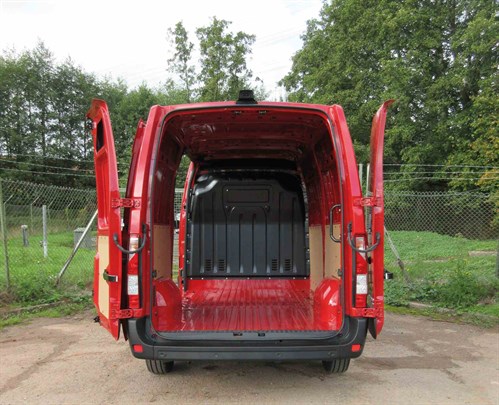
Load bay
Access to our van’s cargo bay was by means of a sliding nearside door plus twin rear doors.
The latter could be swung through 90°, then through 270° – an optional arrangement – and latched against the vehicle’s sides if their user-friendly stays were released.
They opened to reveal a load area with no less than 14 tie-down points, including three on each of the rear door pillars.
Grab handles aided both side and rear access.
A shelf above the cab accessible solely from the load area proved to be a handy place to stow tie-down straps.
The sides and doors were partially protected from scratches and scrapes to half their height by hardboard, but there was no cover for the floor and no protection for the wheel boxes.
Externally, side rubbing strips protected the Movano from minor dings and scrapes.
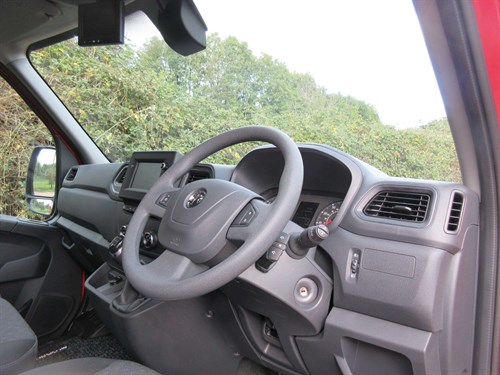
Interior and equipment
If you are the sort of driver who has to carry umpteen bits and pieces of equipment around with you then you will not be short of places to put them. The cab – a three-seater in our case – boasts numerous (Vauxhall says 22) useful nooks and crannies capable of housing everything from a flask of tea to a clutch of pens and a notebook.
Storage facilities include three shelves on top of the dashboard, more shelves above the windscreen, a glove box which, although it has the drawback of not being lockable, has plenty of room inside, and capacious bins in each of the doors with a moulding that can hold a big bottle of water. Yet another shelf sits two-thirds of the way down the fascia and accommodates a 12V power point, but has the drawback that it restricts the centre passenger’s legroom.
Pull up either one or both of the passenger seat cushions and you will find sufficient space underneath to conceal power tools and a tablet computer or two from prying eyes.
Flip the back of the middle seat downwards and a desk is revealed with a section that can be swivelled towards the driver for easier use. The desk is an option, along with the aforementioned under-seat storage, and boasts a couple of cupholders. You will find two more at each extremity of the dashboard.
Our demonstrator boasted a driver’s airbag, optional air-conditioning, electric windows and electrically adjustable and heated exterior mirrors. It was additionally equipped with Navi Pro, which includes a 7.0in colour touch-screen, a DAB radio, Bluetooth compatibility, Apple CarPlay and Android Auto interfaces, satellite navigation and a three-year subscription to TomTom Live. Remote audio controls are mounted on the steering column and both the column and the driver’s seat are height-adjustable.
Rearward vision is about the best you are going to get in a van with a full-height opaque bulkhead and opaque rear doors.
Aside from the aforementioned mirrors, the Movano was fitted with reversing sensors and a reversing camera – both options – which shows an image of what is directly to the rear of you on a screen in the middle of the dashboard. Front parking sensors are included in the deal.
A separate, optional, smaller screen gives you a constant medium- to long-distance view of the road behind as you are travelling along – unless you switch it off.
In a neat twist, a wide-angle mirror on the inside of the passenger sun visor allows the driver to see if anything or anybody – a cyclist, for example – is sitting in the vehicle’s nearside blind spot. That could be a life-saver if the driver is about to turn left without being aware of a vulnerable road user’s presence. As it happens, our van had blind spot alert, which uses ultrasonic sensors to achieve the same goal on both sides of the vehicle, using LED indicators in the mirror on the side where the hazard has appeared to warn the driver.
It also featured lane departure warning, which sounds an alarm if the vehicle strays out of lane. Both are included in an extra-cost Advanced Safety Assistance Pack.
ABS is standard, as are electronic stability programme, emergency brake assist, electronic brakeforce distribution and hill-start assist. Side-wind assistant is standard too, designed to prevent the van being blown into an adjacent lane on the motorway in a crosswind.
Disc brakes are fitted all round on the Vauxhall Movano and are ventilated at the front.
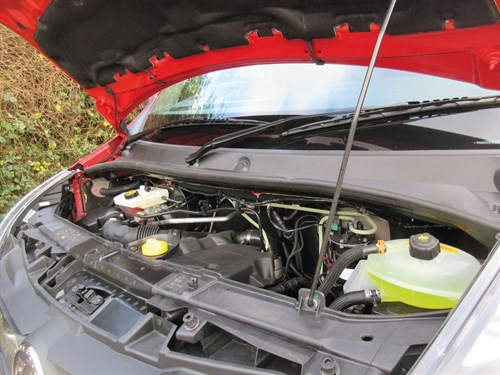
Engine and gearbox
Our Movano’s four-cylinder 16-valve double overhead camshaft engine delivers its maximum output at 3,500rpm. Top torque of 385Nm bites at 1,750rpm.
Twin variable-geometry turbochargers are fitted with common-rail fuel injection and an intercooler.
The filler point for the AdBlue tank is under a flap close to the driver’s door. You’ll find the diesel filler point beneath a flap close to the passenger door.
The introduction of the Worldwide Harmonised Light Vehicle Test Procedure (WLTP) has resulted in a divergence in the arrangements governing engine provision. Front-wheel drive Movanos are equipped with transversely mounted 2.3-litre diesels at 135hp and 180hp as well as at 150hp, which have been homologated in line with the Light Duty Euro6d-Temp regulations and must comply with WLTP.
Rear-wheel drive versions have the same engine at 130hp, 145hp and 165hp, but mounted longitudinally and homologated in line with the Heavy Duty rules. This means they are exempt from WLTP. Light Duty models are limited in terms of the weight and size of the conversion they can accept. Their Heavy Duty counterparts are not so tightly constrained.
Driving
The front-wheel drive Movano’s independent front suspension features double wishbones and MacPherson struts. A tubular axle and single-leaf springs help to support the rear.
Our van’s 16in wheels were shod with Bridgestone Duravis 225/65/R16C tyres and featured full-diameter plastic covers. You pay an extra £60 for them, which seems a bit cheese-paring.
Power-assisted rack-and-pinion steering gives L2 models a 13.6m kerb-to-kerb turning circle rising to 14.1m wall to wall.
One of the most welcome aspects of the latest Movano is the precision of its handling, The feedback through the steering has a reassuringly meaty feel to it, allowing you to hustle the van through bends with confidence and giving it a feeling of stability. It rides well too, coping with potholes and ridges with rather more ease than some of its competitors can muster.
With 150hp to call on, performance is not an issue. We accelerated briskly away from rest and up through the gears, and found we could easily keep up with motorway traffic.
A smooth gearchange helped, although the quality of the gearchange offered in the Movano/Master/NV400 seems to vary a lot. Sometimes it is issue-free, sometimes it is rather like stirring a bag of marbles with a stick.
In-cab noise levels were alas poorly suppressed, with road noise in particular making its presence felt to an excessive degree.
An Eco Mode button was fitted. Press it and you alter the van’s torque settings and rate of acceleration among other functions, hopefully leading to an up to 10% reduction in fuel usage.
Resorting to Eco Mode will not affect the van’s performance unduly if you are heading down a motorway or dual carriageway half-laden.
If you are climbing a steep hill heavily laden, however, or hauling a trailer then that may be a different matter, and you could find you are struggling. Also installed is stop/start, which can be switched on and off.
Our advice would be to leave it switched on in urban environments in order to cut both diesel consumption and exhaust emissions.
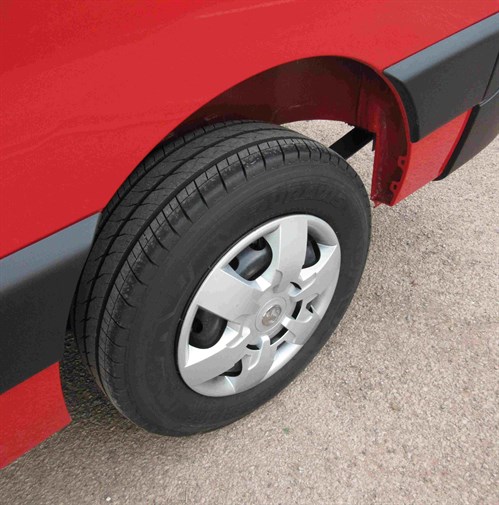
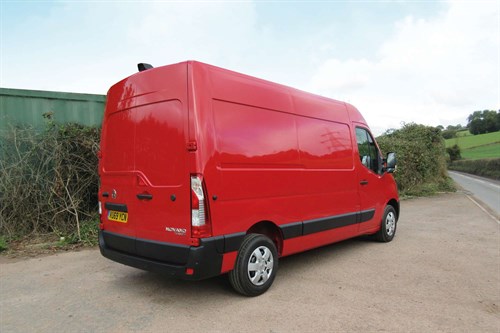
Operating
The Movano is protected by a three-year/100,000-mile warranty while service intervals are set at two years/25,000 miles. Vauxhall quotes an official combined economy figure of 47.8mpg, calculated by translating the WLTP figure into NEDC – New European Driving Cycle – to allow comparisons.
NEDC is being replaced by WLTP. We achieved around 45mpg on our test run.
Movano L2H2 FWD 3.5t 2.3 CDTi 150hp BiTurbo S/S
Price (ex VAT) £32,710
Price range (ex VAT) £27,745-£39,815
Gross payload 1,529kg
Load volume 10.8m3
Load length 3,083mm
Load width (min/max) 1,380/1,765mm
Load bay height 1,894mm
Loading height 562mm
Rear door aperture 1,820 x 1,577mm
Side door aperture 17,80 x 1,270mm
Gross vehicle weight 3,500kg
Braked trailer towing weight 2,500kg
Residual value 14.1%*
Cost per mile 61.0p*
Engine size/power 2,298cc, 150hp @ 3,500rpm
Torque 385Nm @ 1,750rpm
Gearbox 6-speed
Fuel economy 47.8mpg (WLTP combined)
Fuel tank 80 litres
CO2 156g/km
Warranty 3yrs/100,000mls
Service intervals 2yrs/25,000mls
Insurance group 50A
Price as tested ££36,815
*after 4yrs/80,000mls; source: KwikCarcost
Options fitted: Permanent rear-view camera £850; Navi Pro £760; Aircon £700; Advanced Safety Assist. Pack £550; Convenience Pack £450; Front and rear parking sensors and camera £450; 270° rear doors £285; Full-diameter wheel covers £60
Rivals
Ford Transit
Price (ex VAT) £26,235-£38,600
Load volume 9.5-15.1m3
Gross payload 872-2,169kg
Engines 105hp, 130hp, 170hp, 185hp 2.0 diesel, 130hp 2.0 hybrid diesel
Verdict: It’s said nobody ever got shot for buying a Transit and it’s not hard to see why. In its latest incarnation it is on offer with a mild hybrid diesel powertrain, a new 185hp version of its 2.0-litre diesel, a revised front end and a revamped interior. Due to appear in rear-wheel drive soon, the new 10-speed auto should prove popular with home-delivery fleets.
Peugeot Boxer
Price (ex VAT) £24,735-£34,630
Load volume 8.0-17.0m3
Gross payload 1,125-1,570kg
Engines 120hp, 140hp 2.2 diesel
Verdict: The Boxer is sometimes viewed as an also-ran in the panel van market, but that underestimates its capabilities. It has recently been revised, with a new engine plus new trim levels, changes it has in common with its near-identical Citroen Relay cousin. Sharing the same basic design, Fiat’s Ducato has been upgraded too, and all three are worth taking a look at.
Volkswagen Crafter
Price (ex VAT) £25,790-£43,170
Load volume 9.3-17.5m3
Gross payload 735-2,573kg
Engines. 102hp, 122hp, 140hp, 177hp 2.0 diesel
Verdict: Anybody afer a solidly constructed van with the accent on safety is likely to head to Merc’s Sprinter, but take a look at the Crafter before you do. It shares many virtues, and its front assist with city emergency braking package is a potential life-saver in urban areas. An e-Crafter is on its way, and remember the Crafter is also marketed by MAN as the TGE.
The Final Verdict
|
Design |
8/10 |
Plenty of intelligent features, including the Eco Mode button.
|
|
Cabin |
8/10 |
A remarkable amount of storage and a comfy driving position. |
|
Ride |
8/10 |
Better than expected, with potholes causing limited disruption. |
|
Refinement |
6/10 |
In-cab noise levels could be more thoroughly suppressed. |
|
Load area |
8/10 |
Easy to access, low loading height, and a healthy payload. |
|
Handling/performance |
8/10 |
Ample feedback through the steering and brisk acceleration. |
|
Engine/transmission |
7/10 |
Well-matched, with the latter offering a smooth gear-change. |
|
Standard equipment |
7/10 |
Not especially generous, but all the basics are there. |
|
Operating costs |
7/10 |
Sensible service intervals/warranty, and it seems fuel-frugal. |
|
What Van? subjective rating |
8/10 |
A well thought-out package with a lot to offer. |





